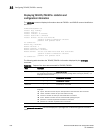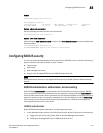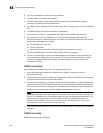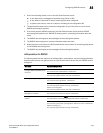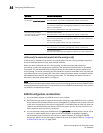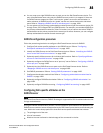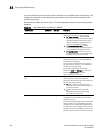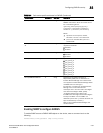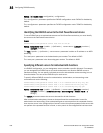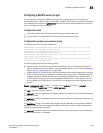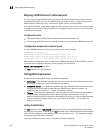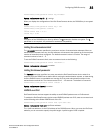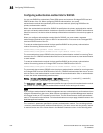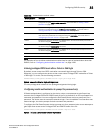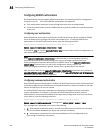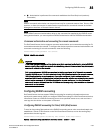
1188 PowerConnect B-Series FCX Configuration Guide
53-1002266-01
Configuring RADIUS security
32
Syntax: [no] enable snmp <config-radius | config-tacacs>
The <config-radius> parameter specifies the RADIUS configuration mode. RADIUS is disabled by
default.
The <config-tacacs> parameter specifies the TACACS configuration mode. TACACS is disabled by
default.
Identifying the RADIUS server to the Dell PowerConnect device
To use a RADIUS server to authenticate access to a Dell PowerConnect device, you must identify
the server to the Dell PowerConnect device.
Example
PowerConnect(config)#radius-server host 209.157.22.99
Syntax: radius-server host <ip-addr> | <iipv6-addr> | <server-name> [auth-port <number>]
[acct-port <number>]
The host <ip-addr> | <ipv6-addr> | <server-name> parameter is either an IP address or an ASCII
text string.
The <auth-port> parameter is the Authentication port number. The default is 1645.
The <acct-port> parameter is the Accounting port number. The default is 1646.
Specifying different servers for individual AAA functions
In a RADIUS configuration, you can designate a server to handle a specific AAA task. For example,
you can designate one RADIUS server to handle authorization and another RADIUS server to
handle accounting. You can specify individual servers for authentication and accounting, but not
for authorization. You can set the RADIUS key for each server.
To specify different RADIUS servers for authentication, authorization, and accounting, enter
commands such as the following.
PowerConnect(config)#radius-server host 1.2.3.4 authentication-only key abc
PowerConnect(config)#radius-server host 1.2.3.5 authorization-only key def
PowerConnect(config)#radius-server host 1.2.3.6 accounting-only key ghi
Syntax: radius-server host <ip-addr> | <ipv6-addr> | <server-name> [auth-port <number>]
[acct-port <number>] [authentication-only | accounting-only | default] [key 0 | 1
<string>]
The default parameter causes the server to be used for all AAA functions.
After authentication takes place, the server that performed the authentication is used for
authorization and accounting. If the authenticating server cannot perform the requested function,
then the next server in the configured list of servers is tried; this process repeats until a server that
can perform the requested function is found, or every server in the configured list has been tried.



